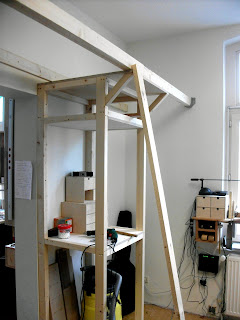building again
I've been pretty busy for the last month and it's been a while now since I have written my last post. I was ordering a lot of stuff, tools and laquers, varnishes and guitar parts. One of my favourite orders and already very much loved tool is the lie nielsen no.7 jointer.
I started the necks but I didn't have the tuners so I couldn't go on with that. And I needed wood. Especially dry wood. But even for the wood I would buy there was no place for storing it. So it was building time again.
Plans were made to install a huge storage shelf which is 80 cm deep and 4,20 m long. That's the length of the room. It's at 2,30 m hight from the floor which gives me almost 70 cm of capacity. Because it will be heavily packed it does need a support.
This is not going to become a telephone box. This shelf will be my "guitar heaven" for go bar clamping and gluing braces to backs and soundboards. And it will also support the wood storage shelf.
Which should be a simple task expect from deciding on the hight of the heaven it turned out quite challenging. The biggest challenge: finding straight wood at the DIY store. I've looked throught 30 or so planks and picked the straightest. Still after the assembly the hole shelf had a twist of several centimeters. To get rid of that I screwed it on the wall. Take that! The wall's not straight either but that's another thing. And the screwing gave even more strenght to the support job of the shelf.
I installed two 60 x 80 mm planks across the room to carry 24mm OSB boards. I drilled holes into those so that the air is able to circulate. The room itself is pretty small. Therefore the shelf should only be as big as needed. I decided for it to be 60 x 60 cm. So the shelf needs an extension to allow for the upper boards to be 80 cms deep.
Air circulation holes will help the wood to season well.
I've been constantly drawing sketches and templates for the bodys for quite a while now and I am very critical about these because I know that these lines may look good on paper but they might not any more after one has assembled the top and sides. Here are some finished templates for the first guitars. These will be x-braced steelstrings.
During my apprenticeship I learned classical guitar making. Very traditional Spanish using hide glue and shellac finishes mixed with modern double top construction and new materials like carbon fibre and epoxy glues. I very much appreciate this. I learned a lot. The most important thing I learned: to work accurate.
I want to keep certain aspects of the classical guitar construction and use them to build contemporary steelstrings. This is what I always wanted to do with my own business cause it's what I play myself and what I enjoy most in the music I listen to. The problem: making steelstrings is a whole new universe. Every part of a steelstring guitar is made different compared to a classical. Starting with wood and it's dimensions to the hardware for the finished guitar. So I've ordered a bunch of 5 different tuners to try them out. Amonst them Gotoh 510s and SGMs, Grovers Sta Tites Vintage Tuners and Waverlys. I will write about those after I tried them all out.
After the wood storage shelf was finished it was time to get the wood. Here's some Spanish cedar, padouk and bubinga I got from a friend. All very beautiful woods and already seasoned for at least 10 years. So they are ready to be worked with and I can't wait!
Another side project was guitar hanging. Simple wooden joinery and some hooks now carry the guitars while they are in construction or waiting to be repaired. I also installed a lot of small hooks to hang tops and backs.













Comments
Post a Comment